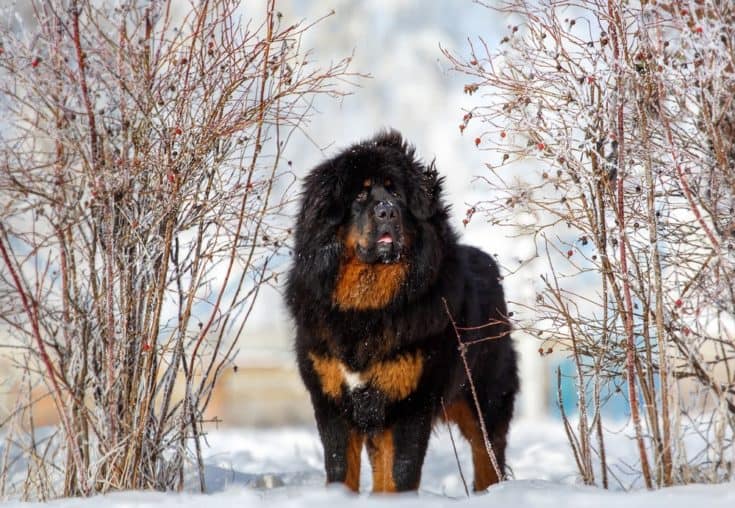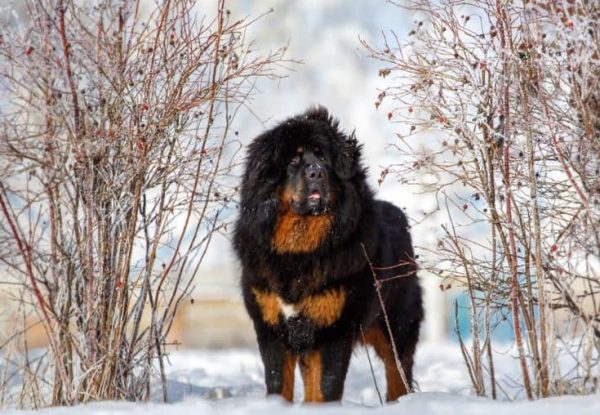Click Below to Skip Ahead
Bred from the Bernese Mountain Dog and the Mastiff, the Mountain Mastiff is a mixed breed known for its muscular body and large head. Like the Mastiff, the Mountain Mastiff has a small muzzle, droopy lips, and small ears. Depending on the genetics of the parents, the Mountain Mastiff may have a short- or medium-length coat.
Though the Mountain Mastiff is new, the parent breeds have been around for a while. The Mastiff is a British breed that was used for its courage and strength, while the Bernese Mountain Dog has been a favorite for farms and ranches in the Swiss Alps for millennia.
Breed Overview
Height:
28 – 38 inches
Weight:
150 – 200 pounds
Lifespan:
7 – 12 years
Colors:
Black, brown, fawn silver, white
Suitable for:
Families with yards, guard dogs, active owners
Temperament:
Smart, friendly, affectionate, protective
The Mountain Mastiff attained some of the best qualities of its parents, including loyalty, intelligence, bravery, and strength. Read more about this designer breed to see if it’s the right choice for your household.
Mountain Mastiff Puppies

As a designer breed, Mountain Mastiff puppies don’t have breed standards or registered breeders. If you find an inexpensive puppy, it could be a sign that you’re dealing with a puppy mill breeder. These dogs are raised in horrid conditions and often suffer health complications, so it’s best to take your time and find a reputable breeder that offers health clearances to ensure the healthiest and happiest possible puppy. When you find a breeder, make sure they let you visit their facilities so you can ensure they have ethical breeding practices. Also, try to meet the puppy’s parents to make sure they’re healthy.
Once you have your Mountain Mastiff puppy, have a comfy bed, treats, and puppy food ready for them to feel welcome in their new home. In the first year and through the life of the dog, you’ll need to think of veterinary care, vaccinations, deworming, spaying or neutering, and any health screenings. Once the puppy is older, you’ll need to take it to the vet for routine care every 6 months.

Temperament & Intelligence of the Mountain Mastiff
The Mountain Mastiff is an easygoing, friendly dog that likes to please its owner. Though suspicious of strangers and exceptional at guarding properties and people, the Mastiff is a warm companion for children and other household pets.
Are These Dogs Good for Families? 👪
The Mountain Mastiff is an ideal choice for families. Because of its size, it can handle the roughness of children and it’s forgiving of mistakes. That said, your Mastiff must be socialized well to avoid aggression and both the dog and the children need to be taught manners and appropriate play. Keep in mind that the Mountain Mastiff can be sensitive to its environment, so it’s not the best choice for households with a lot of loudness or arguing.
Does This Breed Get Along with Other Pets? 🐶 😽
Despite the Mastiff’s history as a gladiator, the Mountain Mastiff is a friendly dog that rarely fights with other dogs. Though protective, the Mountain Mastiff is unlikely to be concerned about small animals like cats and pocket pets. As puppies, Mountain Mastiffs may enjoy chasing rabbits and squirrels in the yard, but they typically outgrow this behavior.
Things to Know When Owning a Mountain Mastiff:
Food & Diet Requirements 🦴
The Mountain Mastiff is a large breed that can eat a lot of food. Make sure you feed high-quality commercial dog food that contains animal protein as the first ingredient to support this muscular breed. You should also consider foods with high carbohydrate content from quality sources like vegetables and whole grains to support energy needs. Avoid soy, corn, and animal byproducts, which can cause digestive upset.
Exercise 🐕
Mountain Mastiffs are highly active and require a lot of exercise each day. The energy levels of the Mountain Mastiff are more like sprints, however, so it’s best to keep exercise sessions short and high-intensity. You can tire the dog out quickly with endurance games and long walks or runs. As your dog ages, its energy level will decrease and it’s important to pay attention so that you don’t push it too far.

Training 🎾
Coming from two intelligent breeds, the Mountain Mastiff is easy to train and takes well to learning. Like most dogs, Mountain Mastiffs respond to positive reinforcement training and rewards-based training. With patience and training, you can teach your dog fun tricks and commands.
Another important aspect of Mountain Mastiff training is socialization with people and animals. As a puppy, you should expose your dog to as many pets and people as possible to get it used to meeting strangers. This will help your dog adjust as it ages and reduces aggression issues. Keep in mind that a large breed like this requires structure and discipline, since a dog this size without manners can cause injuries by accident. If you need help, consult with a certified dog behaviorist to see the best training options.
Grooming ✂️
Depending on the parents, the Mountain Mastiff may have a short- or medium-length coat, so grooming is a breeze. You can brush its coat regularly to keep shedding down and keep the dog clean, but it’s not a high-maintenance breed.
You’ll also need to trim your Mountain Mastiff’s nails every few weeks and ears a few times a month. Dental care is important, so you can brush your dog’s teeth every day or have professional cleanings from your vet. An annual dental cleaning and checkup is the best way to keep your dog’s teeth in good condition and prevent problems. You can teach your dog to tolerate nail trimming, dental cleaning, and ear cleaning by conditioning it as a puppy.
Health and Conditions 🏥
The Mountain Mastiff has a wide lifespan, due to the parent breeds. Generally, large dogs have short lifespans, but otherwise, the Mountain Mastiff is a sound breed. Hip dysplasia, a condition that affects hip joint development and mobility, and cataracts, an eye condition that can lead to blurred vision or blindness, are common genetic conditions.
- Cataracts
- Gastric dilatation-volvulus
- Kidney conditions
- Hip dysplasia
Minor Conditions:
- Cataracts: This is an eye condition marked by fogginess on the lens of the eye, which can affect vision. Over time, cataracts worsen and can lead to blindness.
Serious Conditions:
- Gastric dilatation-volvulus: Also known as bloat, this is a life-threatening condition that causes the stomach to dilate from gas or food. This can put pressure on other organs or cause the stomach to twist, cutting off blood supply and leading to pain or possible death. Large breeds are prone to bloat.
- Kidney conditions: Mountain Mastiffs are prone to amyloidosis, a condition marked by abnormal proteins in the kidneys that cause damage. Mountain Mastiffs may also be prone to other kidney problems.
- Hip dysplasia: This is a genetic condition in which the hip socket doesn’t form correctly, affecting the way the leg moves. Over time, the joint wears down, causing pain and mobility issues. It’s common in large breeds like the Mountain Mastiff.
Male vs Female
Female and male Mountain Mastiffs have similar looks, but the male may be larger than the female. Though slight, this could make a difference with food costs and weight-based medications. Also, spaying females is generally more expensive than neutering males, but it’s a one-time cost. Spaying and neutering can prevent many reproductive cancers and health conditions, so it’s best to spay or neuter your pet as soon as your vet recommends.
Males also tend to be more protective of the home, while females are more suspicious of strangers. Consider which of these personality traits is more suitable for your family.
3 Little-Known Facts About the Mountain Mastiff
1. Mountain Mastiff Parents Are Descendants of an Ancient Breed
Both the Mastiff and the Bernese Mountain Dog are believed to have descended from the Molossus, a massive breed that was revered in Ancient Greece.
2. Romans Brought the First Bernese Mountain Dog to Switzerland
The Bernese Mountain Dog is believed to have been introduced to Switzerland by the Romans over 2,000 years ago.
3. Julius Caesar Used Mastiffs to Fight Lions
Like the Molossus, Mastiffs were considered beasts in ancient times and were used by Julius Caesar to fight lions and bears in packs.
Final Thoughts
Developed from two loyal, intelligent, and gentle giants, the Mountain Mastiff has the best traits of the Bernese Mountain dog and the Mastiff. This large dog is an excellent family companion for families with children or other pets, but also enjoys an active lifestyle with single owners as a friend and protector.
See also:
Featured Image Credit: Tatyana Kuznetsova, Shutterstock










